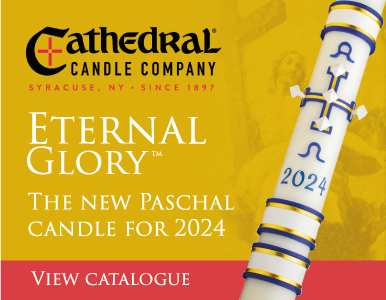Sorry, no records were found. Please adjust your search criteria and try again.
Sorry, unable to load the Maps API.
As part of the Jubilee work undertaken by the Fabbrica di San Pietro, the office managing Saint Peter’s Basilica, the protective glass in the chapel housing Michelangelo’s Pietà has been replaced. The previous glass pane installed in 1973 was designed to protect the sculpture, which had been damaged by blows from a hammer by a man on 21 May 1972. The new protection, as described in a statement by the Fabbrica di San Pietro features a system with a high-tech anchoring system made up of nine shatterproof and bulletproof panes of the highest quality and transparency designed by a team of Italian experts following extensive study.
The replacement took just under six months and is aimed to give pilgrims and visitors the best possible view of the Marian icon, while also providing enhanced security. With the scaffolding removed, the sculpture is once again fully visible in all its glory. “In today’s highly delicate global geopolitical context,” said Cardinal Mauro Gambetti, Archpriest of Saint Peter’s Basilica and President of the Fabbrica di San Pietro, “the faithful are once again able to contemplate the Blessed Mother who offers humanity the Son of God, taken down from the Cross and alive through the power of the Resurrection. The Virgin Mary’s offering opens the way to reconciliation of hearts and the building of paths to fraternity and peace.”
The upgrades
The replacement of the glass pane, fifty years after its installation, became necessary both for aesthetic reasons due to the natural clouding of the material and structural concerns. “The project involved not only the use of more transparent sheets but also mechanically superior ones,” explained engineer Alberto Capitanucci, head of the technical office at the Fabbrica di San Pietro. “The adopted thickness is 24.5 millimetres, compared to the original 19 millimetres (11 millimetres for the upper part). The sheets are not just layered but also thermally hardened. They can withstand up to 26 hammer/axe blows (close to P6B under EN 356 standards) and offer bullet resistance beyond the BR2/S level (EN 1063), meaning they can resist attacks from 9mm calibre pistols.” In total, the stained-glass window, including both the glass panels and the structural steel elements integrating them, covers an area of approximately 50 square metres, weighs 3,400 kilograms, and is designed to withstand major environmental forces, such as pressure and vacuum forces acting on the entire surface, seismic activity, and crowd pressure on the balustrade, all with significant safety margins. The intervention combines greater visibility with enhanced security.
Thanks to Benefactors
The project was conceived, realised, and funded thanks to donations from a group of entrepreneurs and professionals from Italy’s Piedmont region. Among the donors were Banca Sella – Sanlorenzo Spa, Brenntag Spa, Inalpi Spa, Costruzioni Generali Gilardi Spa, MdM Srl – Studio Miroglio and Lupica Associati Architects, Romoli Venturi & Partners, in collaboration with Oxlip, Sagep Editori, Magon Sistemi Spa, Mollo Noleggio, and with the patronage of Confindustria Piemonte.
New lighting
Light is the key element of this upgrading work. The Pietà sculpture group and the entire chapel have been equipped with a new, modern lighting system, completely renewed with the latest-generation technologies and components. The Italian company iGuzzini, which originally designed and implemented the lighting system back in 2017, has donated the new light fixtures, with a non-invasive design, installed after careful studies on lighting spaces and environments.
Further renovation
Thanks to the scaffolding erected for the installation of the large stained-glass window, the Fabbrica di San Pietro also carried out a series of consolidation and restoration works on the frescoed surfaces of the Pietà Chapel (one of the few remaining in the Basilica), created by the painter Giovanni Lanfranco between 1629 and 1632. The security of the arched stained-glass window at the back of the chapel was also ensured.
The Pietà Chapel
The central theme of the entire decorative cycle of the Pietà Chapel is the exaltation of the Cross and its saving power. Until the mid-18th century, the chapel was dedicated to the Crucifix, as a wooden crucifix was once housed there, now located in the Chapel of the Most Blessed Sacrament. The vault features the only frescoes in St. Peter’s Basilica, executed by Giovanni Lanfranco (1582-1647) between 1629 and 1632. The entire vault is decorated with episodes from the Passion of Christ, with the central focus being the exaltation of the Holy Cross, surrounded by a swirl of angels. This central depiction is complemented by painted panels showing episodes from Christ’s Passion, rendered with vivid realism.
Michelangelo’s Pietà
The marble group depicting the Sorrowful Mother, who in her youthful purity tenderly cradles her dead Son, was sculpted by Michelangelo Buonarroti in 1498-99, when he was just 23 years old, for the tomb of Cardinal Jean de Bilhères-Lagraulas, which was originally located in the Chapel of Santa Petronilla, next to the old basilica. The inscription on the ribbon descending from the Virgin’s shoulder reads: “michael āgelvs bonarotvs florent facieba” (Michelangelo Bonarroti of Florence made it), the artist’s only signed work. On December 3, 1749, the statue was placed before a marble crucifix on the altar of this chapel, where it has remained on display for the devotion of the faithful, except for a few months in 1964-1965, when it made a unique and unprecedented journey across the ocean for the New York World’s Fair. On May 21, 1972, following the tragic attack that damaged the Virgin’s left arm and face, the statue, expertly restored, was protected by the large glass pane, which has now been replaced.




































